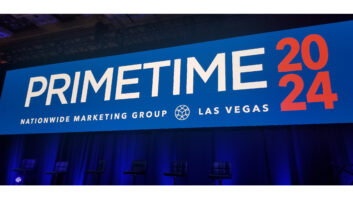New York— The country’s largest retail chain and one of the largest producers of digital prints is hoping to increase photo printing sales beyond sheer volume printing.
According to Joe Lisuzzo, Wal-Mart photo center operations marketing and new technology director, Wal-Mart’s strategy entails a new partnership with HP’s online subsidiary Snapfish, an expanded trial of HP’s Photo Studio kiosks, and new ventures to promote camera phone printing and online image storage to the masses.
“The 4-by-6 market has become commoditized faster in the digital era than it did in the film era,” Lisuzzo said. “Today you can get cheaper digital prints than you can film prints, even though our costs are equal. So we have to step back.”
It is not just the rapid price compression that’s driving the reevaluation, but new consumer habits engendered by digital technology. “Consumers are shooting more photos than ever, but prints are lower than ever. So we have to take the images they like and make more money off of them.”
To that end, Wal-Mart will transition some duties for its online “PhotoCenter” Web site to Snapfish in the fall. The site is currently run by both Wal-Mart and Fujifilm’s E-Systems division and Fujifilm will continue to link Wal-Mart’s Web site to its in-store printing equipment.
“We were trying to solve a dilemma,” Lisuzzo said. “Every time anyone reviewed photo Web sites, ours was always fourth or fifth, and Snapfish was always one or two.”
Lisuzzo added that the company attempted to leverage the best capabilities of both partners. “Snapfish can provide a great customer interface and Fujifilm is expert at delivering images back to the store.”
Snapfish will also help the retailer up-sell higher ticket photo items. “We have always embraced the idea of ancillary photo items. We think Snapfish does an excellent job of bringing those items to the attention of our customers when they’re ordering a 4-by-6 online.”
Wal-Mart has offered net-to-retail printing since 2003 and, along with Ritz Camera, was Fujifilm’s first customer to introduce the model with a one-hour turnaround time. Since then, online orders that are picked up in store in an hour represent a “substantial” portion of the company’s online photo printing business, Lisuzzo said.
Indeed, even though the one-hour service costs more, most consumers choose an in-store pickup option with a rapid turnaround time, said Gael Lundeen, photofinishing and Web services VP and GM, Fujifilm.
Wal-Mart will also expand a test of HP’s Photo Studio kiosk, a modular system announced at the Photo Marketing Association’s show earlier this month, dedicated to producing photo books, large format posters and calendars in-store with a quick turnaround time. The company was testing the kiosk in two Wal-Marts and two Sam’s Club locations and will expand the test toa total of 50 stores.
The company enjoyed good results from its initial test locations, but decided to keep the product rollout in a test phase “because it’s a brand new customer solution, and this is HP’s first foray into retail,” Lisuzzo said, adding that the relationship would be collaborative. “We can teach them about retail photo printing, and they can help us with new technology.”
Since the model of on-site photo novelty production is new, the retailer wants more data before it commits to a wider rollout, but Lisuzzo noted that initial customer reaction had been positive and the company was very impressed with the technology.
Lisuzzo said that Wal-Mart — and the industry’s — next challenge was to tackle the vast stores of digital images sequestered on consumers’ computers. He pointed out that the company, and industry in general, had an obligation to migrate image storage away from hard disk drives which can crash, to more secure media. “We promoted digital, and the customer bought in in a big way. So now we have an obligation to help them with these issues.”
The company already offers long-term image storage on its Photo Center Web site for a fee, but is looking to “build that out for a lower cost” and make “lifetime storage” a viable business model for a mainstream audience. “We have to get the message across in a non-threatening and inexpensive way,” he said. The push will involve “more CDs and DVDs” and other storage solutions, he said.
As for another potential print source — camera phones — Lisuzzo noted that they had the potential to be the “one time use camera of the future but no one has an easy solution” for getting the images off the camera and into output. “Even Bluetooth is cumbersome.”
Wal-Mart is working on a solution to allow camera phone users to upload images from their phones to nearby locations for printing. “We have to change the industry,” Lisuzzo said, from a mindset of burning airtime to one where pictures can be moved quickly and easily out of the camera. “It’s not a real camera unless you can easily get your pictures off the phone.”
He noted that the company has an “application idea” that will address the whole industry. Changing the prevailing mindset among carriers won’t be easy, he said, “but it’s doable.”
The final chunk of the output pie, home printing, is not a threat but a boon to retail, Lisuzzo said. “We don’t view home printing as a threat, and we believe it will continue to represent 40 to 45 percent of the market for digital prints,” he said. In that case, “We’ll be more than happy to sell you paper and ink.”
“The photo business means output,” he added. “The day we stop printing pictures is the day we’re out of business.”













